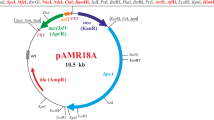Summary
Streptomyces coelicolor “Müller” is known to excrete the lysozyme N-acetylmuramidase. Culture filtrates of this strain form a characteristic halo on agar plates containing freeze-dried Micrococcus luteus cells (lysoplate technique). The halo consists of a clear inner zone and a turbid outer ring. Simulation experiments showed that the turbid outer ring is most probably produced by lysozyme whereas the clear inner zone can be considered to be due to an additional protease action. Using the lysoplate technique UV- and NTG-mutagenized strains of S. coelicolor “Müller” were screened for mutants defective in lysozyme production. Two mutants, SC11 and SC12, were identified. The mutant SC11 was selected for complementation studies. First, a transformation system was established. The use of a soft-agar overlay method was necessary to yield high regeneration rates of SC11 protoplasts. The plasmid vector pEB15 could be transferred into this mutant strain with an efficiency of 105 transformants/μg DNA. The high efficiency allowed shot-gun cloning experiments. Genomic DNA of S. coelicolor “Müller” digested with Sau3A and inserted into pEB15 was introduced into the mutant SC11. A complemented mutant was identified. A 2.9 kilobase pair (kb) DNA fragment was found which restored the lysozyme production of both mutants, SC11 and SC12. According to the diameter of the produced halos the complemented mutant SC11 was suggested to produce more lysozyme than the wildtype strain.
Similar content being viewed by others
References
Altenbuchner J, Cullum J (1984) DNA amplification and an unstable arginine gene in Streptomyces lividans 66. Mol Gen Genet 195:134–138
Hayashi K, Seino A, Kasumi T, Kubo N, Tsumura N (1981) Bacteriolytic enzyme produced by Streptomyces sp. J Ferment Technol 59:319–323
Hodgson DA (1982) Glucose repression of carbon source uptake and metabolism in Streptomyces coelicolor A3(2) and its perturbation in mutants resistant to 2-deoxyglucose. J Gen Microbiol 128:2417–2430
Hooley P, Wellington AMH (1985) Formation and regeneration of protoplasts of Streptomyces hygroscopicus. Lett Appl Microbiol 1:77–80
Hopwood DA (1967) Genetic analysis and genome structure in Streptomyces coelicolor. Bacteriol Rev 31:373–403
Hopwood DA, Bibb MJ, Chater KF, Kieser T, Bruton CJ, Kieser HM, Lydiate DJ, Smith CP, Ward JM, Schrempf H (1985) Genetic manipulation of Streptomyces: a laboratory manual. John Innes Foundation, Norwich
Hughey VL, Johnson EA (1987) Antimicrobial activity of lysozyme against bacteria involved in food spoilage and foodborne disease. Appl Environ Microbiol 53:2165–2170
Jollès P, Jollès J (1984) What's new in lysozyme research? Molec Cell Biochem 63:165–189
Kawata S, Takemura T, Yokogawa K (1983) Characterization of two N-acetylmuramidases from Streptomyces globisporus 1829. Agric Biol Chem 47:1501–1508
Kieser T (1984) Factors affecting the isolation of ccc DNA from Streptomyces lividans and Escherichia coli. Plasmid 12:19–36
Okanishi M, Suzuki K, Umezawa H (1974) Formation and reversion of streptomycete protoplasts: cultural conditions and morphological study. J Gen Microbiol 80:389–400
Osserman EF, Lawlor DP (1966) Serum and urinary lysozyme (muramidase) in monocytic and monomyelocytic leukemia. J Exp Med 124:921–951
Schleifer KH, Kandler O (1972) Peptidoglycan types of bacterial cell walls and their taxonomic implications. Bacteriol Rev 36:407–477
Shirahama T, Furumai T, Okanishi M (1981) A modified regeneration method for streptomycete protoplasts. Agric Biol Chem 45:1271–1273
Shugar D (1952) The measurement of lysozyme activity and the ultra-violet inactivation of lysozyme. Biochim Biophys Acta 8:302–309
Tautz D, Renz M (1983) An optimized freeze-squeeze method for the recovery of DNA fragments from agarose gels. Anal Biochem 132:14–19
Thompson CJ, Ward JM, Hopwood DA (1982) Cloning of antibiotic resistance and nutritional genes in streptomycetes. J Bacteriol 151:668–677
Ward JB, Perkins HR (1968) The purification and properties of two staphylolytic enzymes from Streptomyces griseus. Biochem J 106:69–76
Author information
Authors and Affiliations
Additional information
Dedicated to Professor Dr. Dr. h. c. K. Esser on the occasion of his 65th birthday
Rights and permissions
About this article
Cite this article
Birr, E., Wohlleben, W., Aufderheide, K. et al. Isolation and complementation of mutants of Streptomyces coelicolor “Müller” DSM3030 deficient in lysozyme production. Appl Microbiol Biotechnol 30, 358–363 (1989). https://doi.org/10.1007/BF00296624
Received:
Accepted:
Issue Date:
DOI: https://doi.org/10.1007/BF00296624




